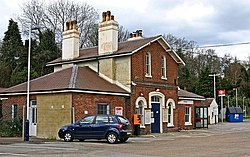Witley
- Not to be confused with Whitley
| Witley | |
| Surrey | |
|---|---|
 Houses on Petworth Road, Witley | |
| Location | |
| Grid reference: | SU947398 |
| Location: | 51°8’60"N, -0°38’46"W |
| Data | |
| Population: | 8,130 (parish, 2011) |
| Post town: | Godalming |
| Postcode: | GU8 |
| Dialling code: | 01428 |
| Local Government | |
| Council: | Waverley |
| Parliamentary constituency: |
South West Surrey |
Witley is a village in south-western Surrey, two and a half miles south-west of Godalming and six and a half miles south-west of the county town, Guildford. The land is made up of mixed rural (from woods to cultivated fields, including some of the forested Greensand Ridge) and suburban areas.
As a civil parish it is unusual in that it includes the small town of Milford in the north. Occupying its hills in the south-west are Sandhills and Brook.
Witley Common is a wide National Trust expanse crossed by the Portsmouth Road (the A3). The village is served by two stations on the line to Portsmouth: Witley station, actually sited to the south in nearby Wormley, and, to the north, Milford station, which is more or less equidistant between Milford and Witley.
The village has a parish church which dates for before the Norman Conquest.
The village has a private sector, charitable co-educational boarding and day school founded in 1553 by King Edward VI and Nicholas Ridley.
History

Witley appears in the Domesday Book of 1086 as Witlei. Its Domesday assets were held by Gislebert (Gilbert), son of Richere de L'Aigle. It rendered: 12 hides; 1 church, 15 ploughs, 3 acres of meadow, woodland worth 30 hogs, in the Godalming Hundred and rendered £16.[1]
In 1848, Samuel Lewis's "Topographical Dictionary" describes Witley as:
A parish, in the union of Hambledon...containing 1488 inhabitants...situated on the road from Godalming to Petworth, and comprises 6,324 acres, of which 3,150 acres are arable, 900 acres pasture, 1,100 acres wood, and 1,174 acres waste. A pleasure-fair is held on the 23rd of April. The living is a discharged vicarage, with that of Thursley annexed, valued in the king's books at £17. 15. 10.; patron and incumbent, the Rev. J. Chandler; the great tithes of Witley have been commuted for £13, and the small for £200. The church is a cruciform structure, principally in the early English style, with a central tower surmounted by a spire, and contains monuments to the Chandler and Webb families, and some ancient brasses. A district church, dedicated to St. John the Evangelist, was built at Milford in 1836: the living is in the gift of the Brodrick family. There is a place of worship for Calvinists.
Sights of the village

- All Saints' Church is built from surviving Anglo-Saxon England stonework and later Norman architecture, demonstrating that the village has existed since at least Saxon times. The church building was transformed by the Normans and enlarged into a cruciform shape towards the end of the 12th century, when its tower was also erected. The church contains an inscribed stone, set in the chancel wall, bearing the name of the Duke of Clarence (see below), which is believed to be part of an unfinished memorial to one of his bailiffs.[2][3] The church is Grade I listed.[4]
- Witley Park, the home of Whitaker Wright, was built in the 1890s at a cost of £1.85 million. It was one of the most lavish private residences in the world. The grounds included a series of three interconnecting lakes and an underwater billiard room. The main building burnt to the ground in 1953. Today the grounds and remaining buildings are private family homes.
- Old Cottage and Step Cottage, dating from the 15th and 16th centuries, are close to the church.
- The White Hart, the village public house, is mostly Elizabethan and is said to stand on the site of a Saxon inn.
Semaphore/Telegraph Station
On Bannicle or Bannack Hill there was an Admiralty telegraph station which was built in 1822 as part of a semaphore line between the Admiralty in London and Portsmouth. It was about 30 yards east of Hill House, but no trace of the station remains.[5] William Cobbett in Rural Rides referred to the station when travelling through the hills of Hambledon. "On one of these hills is one of those precious jobs, called semaphores. For what reason this pretty name is given to a sort of Telegraph house, stuck up at public expense upon a high hill; for what reason this outlandish name is given to the thing, I must leave the reader to guess; but as to the thing itself; I know that it means this; a pretence for giving a good sum of public away every year..."[6]
Witley Common
Witley Common, which belongs to the National Trust, directly adjoins many localities of the village.[7]
Hamlets
Cramhurst, Wheelerstreet, Crossways and Culmer are hamlets in the parish, forming a clustering with Witley's own historic centre.
Also in the parish are Sandhills, Brook and most of Wormley.

Outside links
| ("Wikimedia Commons" has material about Witley) |
References
- ↑ Surrey Domesday Book
- ↑ All Saints (Church of England community website)
- ↑ The Church of England - All Saints Church, Witley
- ↑ National Heritage List 1260732: All saints' Church, Witley
- ↑ Historic Environment RecordHER 3504 - Admiralty Telegraph Station circa 1822 (Site of)
- ↑ William Cobbett Rural Rides Penguin English Library 1967
- ↑ Witley Common